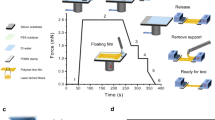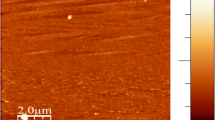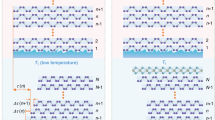Abstract
Thin films of organic materials are finding many applications in modern technology. The microelectronics industry, in particular, uses very thin organic films both as photoresists and as insulating layers. The ultimate in organic thin films is represented by molecular monolayers of the order of 2.0 nm thick as deposited by the Langmuir–Blodgett technique1. By adapting a vibrating reed apparatus2 we have investigated the thermal–mechanical properties of a supported 6-nm thick monolayer film.Although a monolayer melting transition could not be found in the resultant spectra, at least two other, low-temperature peaks (at −150 and −20 °C) were detected which seem to be due to relaxation processes both within the film as well as at interfaces of the monolayer structure. Our main aim was to determine whether the mechanical properties of ultrathin films could be measured by the vibrating reed technique, and to detect any thermal–mechanical relaxations which may occur in such films, inparticular whether or not a melting transition could be detected at elevated temperatures. Such thermal–mechanical measurements have long been used in theplastics industry to characterize the mechanical properties of resin materials in bulk. The vibrating reed technique may provide an analogous service for very thin organic coatings.
This is a preview of subscription content, access via your institution
Access options
Subscribe to this journal
Receive 51 print issues and online access
$199.00 per year
only $3.90 per issue
Buy this article
- Purchase on Springer Link
- Instant access to full article PDF
Prices may be subject to local taxes which are calculated during checkout
Similar content being viewed by others
References
Gaines, G.L. Jr in Insoluble Monolayers at Liquid–Gas Interfaces Ch. 8 (Wiley-Interscience, New York, 1966).
Berry, B. S. & Pritchet, W. C. I.B.M. J. Res. Devl. 19, 334 (1975).
Pindak, R., Bishop, D. J., Osheroff, D. D. & Sprenger, W. O. Paper int. Conf. on Ordering in Two Dimensions, Lake Geneva, Wisconsin (1980).
Pindak, R., Bishop, D. J. & Sprenger, W. O. Phys. Rev. Lett. 44, 1461 (1980).
Tarczon, J. C. & Miyano, K. Paper int. Conf. on Ordering in Two Dimensions, Lake Geneva, Wisconsin (1980).
Bishop, D. J. & Reppy, J. D. Phys. Rev. Lett. 40, 1727 (1978).
Anderson, O. L. & Bömmel, H. E. J. Am. ceram. Soc. 38, 125 (1955).
Kellner, B. M. J. Tech. Rep. TR22. 2326 (International Business Machines Corporation, Hopewell Junction, New York, 1980).
Anderson, H. R. Jr, & Swalen, J. D. J. Adhes. 9, 197 (1979).
Stephens, J. F. J. Colloid Interf. Sci. 38, 577 (1972).
Bowden, F. P. & Tabor, D. The Friction and Lubrication of Solids, Part I, 209 (Oxford University Press, 1964).
Arridge, R. G. C. Mechanics of Polymers, 95–96 (Clarendon, Oxford, 1975).
Author information
Authors and Affiliations
Rights and permissions
About this article
Cite this article
Lacombe, R., Kellner, B. Thermal-mechanical properties of a monomolecular film detected by a vibrating reed. Nature 289, 661–662 (1981). https://doi.org/10.1038/289661a0
Received:
Accepted:
Issue Date:
DOI: https://doi.org/10.1038/289661a0
This article is cited by
-
A novel method for determining the melting behavior of ultrathin films
Colloid and Polymer Science (1985)
Comments
By submitting a comment you agree to abide by our Terms and Community Guidelines. If you find something abusive or that does not comply with our terms or guidelines please flag it as inappropriate.



